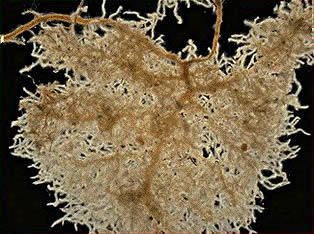Proteoid Roots
As with mycorrhizae, proteoid roots increase the absorbtive capacity of the plant
by increasing the effective area of contact between the root and the soil.
This increase in surface area may be up to 16 times that of comparable non-proteoid roots.
Proteoid roots are relatively short-lived (2-3 months) and are typically produced during winter and spring. Their development is favoured by low nutrient conditions, especially low P availability and they are known to secrete organic acids which are capable of solubilizing soil phosphates.

A large proteoid root of Banksia integrifolia showing the tangled arrangement of fine branched rootlets which greatly increases the absorptive area of the root.
